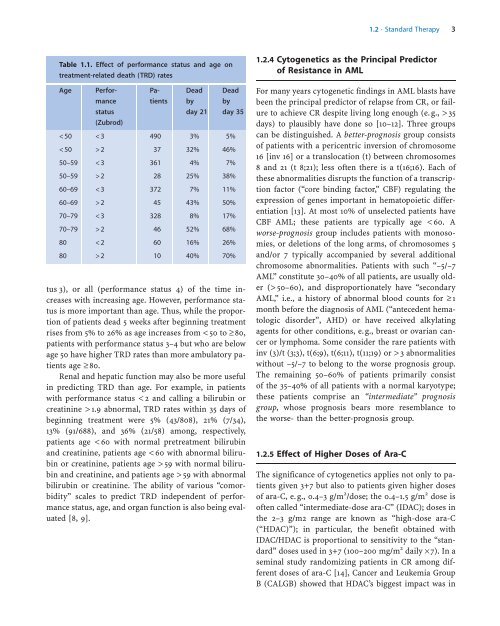Acute Leukemias - Republican Scientific Medical Library
Acute Leukemias - Republican Scientific Medical Library
Acute Leukemias - Republican Scientific Medical Library
Create successful ePaper yourself
Turn your PDF publications into a flip-book with our unique Google optimized e-Paper software.
a 1.2 · Standard Therapy 3<br />
Table 1.1. Effect of performance status and age on<br />
treatment-related death (TRD) rates<br />
Age Performance<br />
status<br />
(Zubrod)<br />
Patients<br />
Dead<br />
by<br />
day 21<br />
Dead<br />
by<br />
day 35<br />
59 with abnormal<br />
bilirubin or creatinine. The ability of various “comorbidity”<br />
scales to predict TRD independent of performance<br />
status, age, and organ function is also being evaluated<br />
[8, 9].<br />
1.2.4 Cytogenetics as the Principal Predictor<br />
of Resistance in AML<br />
For many years cytogenetic findings in AML blasts have<br />
been the principal predictor of relapse from CR, or failure<br />
to achieve CR despite living long enough (e. g., > 35<br />
days) to plausibly have done so [10–12]. Three groups<br />
can be distinguished. A better-prognosis group consists<br />
of patients with a pericentric inversion of chromosome<br />
16 [inv 16] or a translocation (t) between chromosomes<br />
8 and 21 (t 8;21); less often there is a t(16;16). Each of<br />
these abnormalities disrupts the function of a transcription<br />
factor (“core binding factor,” CBF) regulating the<br />
expression of genes important in hematopoietic differentiation<br />
[13]. At most 10% of unselected patients have<br />
CBF AML; these patients are typically age < 60. A<br />
worse-prognosis group includes patients with monosomies,<br />
or deletions of the long arms, of chromosomes 5<br />
and/or 7 typically accompanied by several additional<br />
chromosome abnormalities. Patients with such “–5/–7<br />
AML” constitute 30–40% of all patients, are usually older<br />
(> 50–60), and disproportionately have “secondary<br />
AML,” i.e., a history of abnormal blood counts for ³ 1<br />
month before the diagnosis of AML (“antecedent hematologic<br />
disorder”, AHD) or have received alkylating<br />
agents for other conditions, e.g., breast or ovarian cancer<br />
or lymphoma. Some consider the rare patients with<br />
inv (3)/t (3;3), t(6;9), t(6;11), t(11;19) or > 3 abnormalities<br />
without –5/–7 to belong to the worse prognosis group.<br />
The remaining 50–60% of patients primarily consist<br />
of the 35–40% of all patients with a normal karyotype;<br />
these patients comprise an “intermediate” prognosis<br />
group, whose prognosis bears more resemblance to<br />
the worse- than the better-prognosis group.<br />
1.2.5 Effect of Higher Doses of Ara-C<br />
The significance of cytogenetics applies not only to patients<br />
given 3+7 but also to patients given higher doses<br />
of ara-C, e.g., 0.4–3 g/m 2 /dose; the 0.4–1.5 g/m 2 dose is<br />
often called “intermediate-dose ara-C” (IDAC); doses in<br />
the 2–3 g/m2 range are known as “high-dose ara-C<br />
(“HDAC)”); in particular, the benefit obtained with<br />
IDAC/HDAC is proportional to sensitivity to the “standard”<br />
doses used in 3+7 (100–200 mg/m 2 daily ´7). In a<br />
seminal study randomizing patients in CR among different<br />
doses of ara-C [14], Cancer and Leukemia Group<br />
B (CALGB) showed that HDAC’s biggest impact was in
















